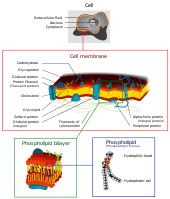
Photo from wikipedia
Cells respond to stress by blocking translation, rewiring metabolism and forming transient messenger ribonucleoprotein assemblies called stress granules (SGs). After stress release, re-establishing homeostasis and disassembling SGs requires ATP-consuming processes.… Click to show full abstract
Cells respond to stress by blocking translation, rewiring metabolism and forming transient messenger ribonucleoprotein assemblies called stress granules (SGs). After stress release, re-establishing homeostasis and disassembling SGs requires ATP-consuming processes. However, the molecular mechanisms whereby cells restore ATP production and disassemble SGs after stress remain poorly understood. Here we show that upon stress, the ATP-producing enzyme Cdc19 forms inactive amyloids, and that their rapid re-solubilization is essential to restore ATP production and disassemble SGs in glucose-containing media. Cdc19 re-solubilization is initiated by the glycolytic metabolite fructose-1,6-bisphosphate, which directly binds Cdc19 amyloids, allowing Hsp104 and Ssa2 chaperone recruitment and aggregate re-solubilization. Fructose-1,6-bisphosphate then promotes Cdc19 tetramerization, which boosts its activity to further enhance ATP production and SG disassembly. Together, these results describe a molecular mechanism that is critical for stress recovery and directly couples cellular metabolism with SG dynamics via the regulation of reversible Cdc19 amyloids.
Journal Title: Nature cell biology
Year Published: 2021
Link to full text (if available)
Share on Social Media: Sign Up to like & get
recommendations!